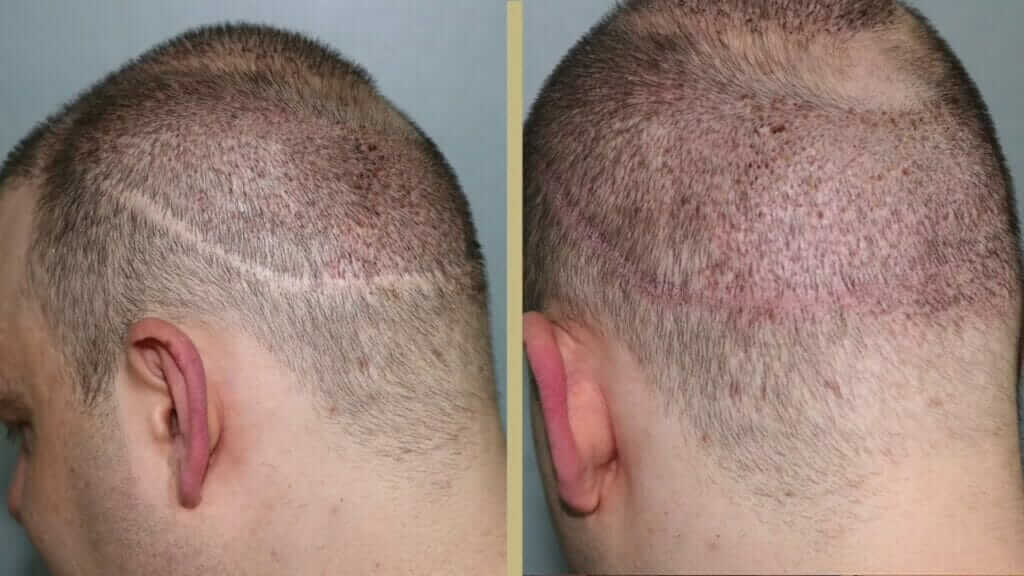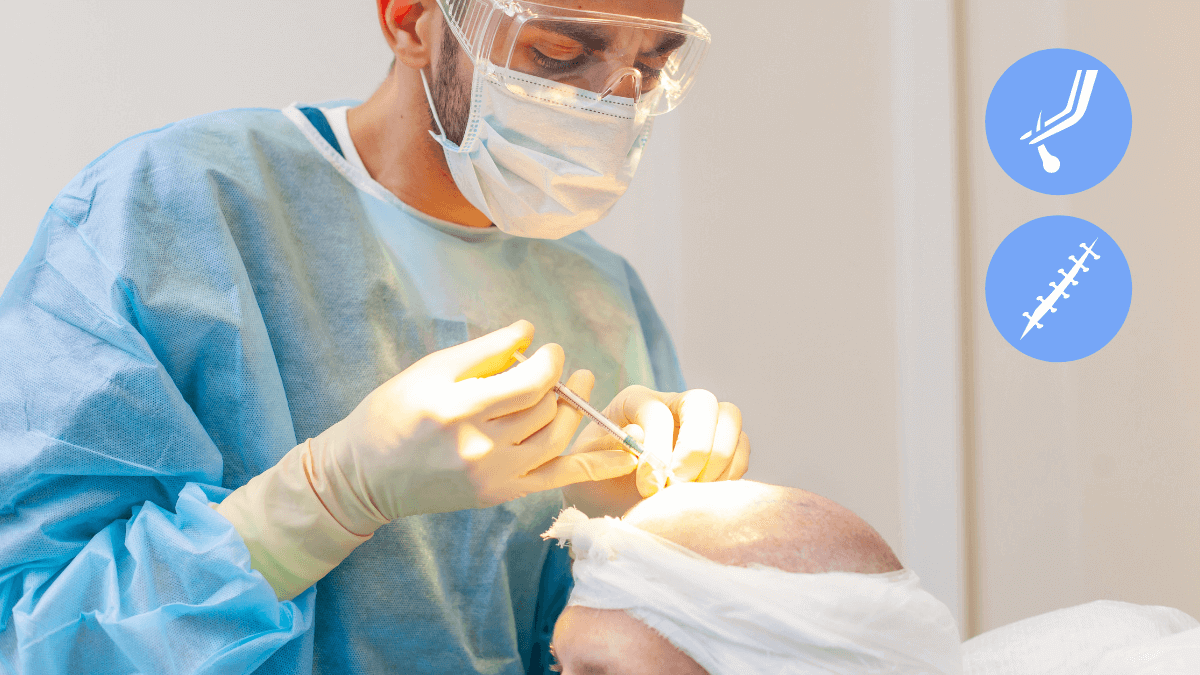TL;DR
▶ FUT is a hair transplant technique where strips of hair follicles are harvested to be planted in bald areas. It’s quite convenient as it takes less effort in a single session than alternatives such as FUE.
▶ Its process has one crucial point. During harvesting, FUT leaves an obvious linear scar on the scalp.
▶ Despite having a success rate of more than 90% of grafts surviving after surgery, FUT has the side effect of visible linear scars on the scalp, among others.
▶ Naturally, to have more natural-looking transplanted hair without permanent scars, FUE should be preferred instead.
The modern hair transplantation techniques date back to 1930s Japan, and there have been various different techniques developed and used since then.
Follicular Unit Transplantation, the standard hair restoration surgery up until the 2000s, has a solid background with a significant amount of clinics and surgeons still supporting and using it.
In this article, I’ll explain what exactly FUT is, its background, and what you should expect if you’re considering getting one.
Table of Contents
What is FUT (Follicular Unit Transplantation)?
Follicular Unit Transplantation, also known as Strip Hair Transplant and abbreviated as FUT, is a hair transplant technique where strips of hair follicles are harvested from the donor area and planted in the bald areas of the scalp.
Preferred because of its convenience and price point, as it allows you to cover large bald areas with less effort in a single session compared to other common hair transplant techniques; FUT is offered in a huge percentage of hair clinics worldwide as a way to regrow lost hair.
Background of FUT
Before FUT, the old-school technique referred to as hair plugs were the only option for treating male pattern baldness.
In these surgeries, the surgeon would remove relatively larger (around 4 millimeters) and round areas of skin and hair and plant them into the bald areas on your scalp.
Patients would have mediocre results and doll-like hairlines with this outdated method, it just wasn’t natural.

Then came the 1990s, and a dermatologist from Texas, US named Bobby Limmer has pioneered the first follicular unit hair transplant surgery. The operation yielded much better and more natural results than the hair plug technique due to being more precise with individual hair strips instead of large plugs.
FUT has quickly become the gold standard in hair transplant procedures.
Since then, FUT has been applied to millions of patients worldwide, with most of the operations going successful. Even though much more advanced and efficient types of hair transplant surgeries were developed in the last 20 years, FUT is still a popular technique used by a large number of clinics and surgeons all over the world.
What does the FUT Process look like?
The process of FUT is roughly similar to any other hair transplant surgery. First, the hair follicles are harvested from the donor areas and then they are planted onto the bald areas of the scalp.
The differentiation comes from how the donor hair is harvested. But let’s rewind to the very first step of getting a hair transplant, to help you understand what exactly you’ll be going through:

FUT Surgery
The very first step of any hair transplant surgery starts with the initial consultation and examination. This is the part where the overall strategy for the operation, the target hairline, and the number of hair grafts that will be harvested and planted are decided.
Your surgeon goes over your medical background, understands the causes of your hair loss, and then highlights a path for the surgery and the next steps.
You don’t have to shave your hair for FUT only if the hairline hair will be restored. Your hairline is drawn and you’re taken to the operation room.
Local anesthesia will be applied to your scalp so you don’t feel anything, and you’ll be awake for the whole operation unless you wish to be sedated by an anesthesiologist.
During the surgical procedure, the surgeon will start by extracting the follicular unit grafts -which is a strip of skin that contains a unit of individual hair follicles- from the donor area.
Once they reach the graft amount they need, they’ll move on to extracting individual follicles from these strips. A technician will usually be operating on the harvested strips while the surgeon uses sutures to close the areas on your scalp where strips were harvested.
Next, the surgeon will place the hair follicles into your scalp one-by-one, until all of the grafts are planted and your desired hairline is reached. And finally, they will apply bandages around your scalp and the procedure will be finalized for now.
You will be able to remove the bandages the next morning and go through your first wash, which usually happens under the supervision of the hair transplant surgeons. Aside from the regular check-ins that you should do with your dermatologist, your time with the medical team is over and the healing process begins.
FUT Cost
A 2000 graft FUT surgery can cost anywhere between $3000 and $10,000 and can go even higher, with the price per graft cost being between $2-$5 and even going up to $7 in some high-end clinics.
The final hair transplant cost of course depends on the clinic’s rates, specifications of your procedure, graft count, and extra services.
Keep in mind that FUT is considerably cheaper than the average FUE surgery since it is relatively easier to operate and takes less time.
How long does FUT take to heal?
After a FUT surgery, the pain, tightness, and itching around your scalp should go away after 2 to 3 days. The areas where the hair grafts were planted should take around 15 days to completely heal, while the scars in donor areas can take up to 3 weeks to heal and get back to normal color.
Full recovery time is around 6-12 months after surgery, where your transplanted hair follicles are regrowing and contributing to natural-looking results.

How long does FUT last?
If the surgery is successful and the majority of the planted hair grafts have survived after at least 12 months -which is the recovery period-, the newly established hairline after FUT is permanent.
The areas of your scalp where a donor strip of hair is harvested are intentionally permanent healthy hair-bearing areas in your scalp. They’re less susceptible to dihydrotestosterone, which is the hormone that is responsible for hair loss in the majority of cases.
So, the planted hair in previously bald areas of your scalp is somewhat immune to hair loss and will keep growing permanently if nurtured right.
Side Effects of FUT
Everything in this article up to this point discussed the process and benefits of having a FUT surgery, and from here I’ll continue with the downsides of this popular hair restoration procedure.
Follicular Unit Transplantation (FUT) is not perfect.
Here are some side effects of having a FUT surgery, most of which are common for all hair transplant techniques:
- Post-surgery Infection: Roughly 1% of hair transplant patients develop an infection following the surgery. This risk of hair transplant infections can be significantly reduced if you prefer to have your hair transplantation by dermatologist doctors who are experts in both skin and hair health.
- Pain
- Bleeding
- Hair Transplant Scabs and Swelling
- Itching
- Numbness
And lastly, because FUT is done using the strip method, you will have visible scarring that will gradually fade away but will never disappear.
And this is why most surgeons and dermatologists do not prefer FUT as their primary hair transplant technique:
FUT Scars – #1 reason to have FUE instead
Compared to Follicular Unit Extraction, a FUT surgery takes much less effort and time and is much more affordable.
So why are FUE and its advanced variations the standard techniques instead of FUT, if it’s so convenient?
The reason is simple: patients don’t want to live with linear scars on their scalp forever and surgeons want to provide as natural results as possible minimally invasive surgery.
Let’s see a few examples of scars caused by FUT surgeries:

As you can see in the picture above, there is a very visible linear scar on the donor area of the patient. This scar looks to be completely healed, but it remains there forever unless the patient goes through another hair transplant surgery to cover up this wide scar.
The patient can hide the scar if they grow their hair to be medium-long, but the scar will always be visible to a certain degree of short hair.
Here’s another example:

FUT scars can be really intimidating and might end up making you very self-conscious about that part of your body. Overall integrity and a natural-looking head of hair are required if you want to be confident about your appearance.
Most patients, after they get a FUT surgery and are left with linear scars, also go through FUE surgery to cover up these scars. Although the results are pretty impressive, why bother putting your body through two surgeries?

Some would consider these visible scars among hair transplant failures alongside hair transplant rejections.
My honest advice as a dermatologist doctor who treated over 50,000 patients through the years, if you have strong donor area, then you don’t need to choose FUT. However for some patients, FUT may be a better option.
In FUE -the more recent surgical technique for hair transplantation- instead of harvesting strips of tissue to get hair grafts, surgeons directly harvest individual hair grafts with a special punching pen. This more precise practice results in:
✅ little scars which quickly heals in the donor area,
✅ no need for stitching or use of sutures,
✅ and a more natural head of hair as the final product.
Combined with UnitedCare’s holistic approach to hair restoration and transplantation, this type of hair transplant can be the perfect path for you to get back to your natural look.
Also, as experts in hair transplantation, we use these sapphire blades, made from expensive gemstone, in FUE operations since we care about the best results possible.
Wondering what the innovative and holistic approach here at UnitedCare looks like? Here’s what to expect. 👈
Ready to get an expert opinion, for free? 👇
Restore your natural look with a Dermatologist:
UnitedCare and its expert dermatologist doctors provide you with a holistic approach to FUE surgeries.
So, is FUT hair transplant worth it?
Although FUT is an innovative approach to hair transplantation, with the invention of the more advanced techniques like FUE, Sapphire FUE, DHI, and even robotic hair transplantation; FUT has already served its purpose as the stepping stone to the future.
Done by the right surgeon, preferably a dermatologist, FUE against FUT yields better and more natural-looking results with none to minimal scarring; isn’t that what you want?
Frequently Asked Questions (FAQs)
What is the success rate of FUT hair transplants?
FUT hair transplants yield on average more than 90% graft survival rate, and up to 99% of patients end up with satisfactory results with the right surgeon.
Does FUT hair transplant leave scars?
Yes, a FUT hair transplant will leave linear scars where the follicular units were harvested; and these scars, although they fade away over time, are permanent and visible if you’re wearing your hair short.
Which is more painful FUE or FUT?
For the average patient, FUT surgery for hair transplantation compared to FUE tends to be more painful because of the harvesting process where a strip of tissue is literally cut from your scalp.

